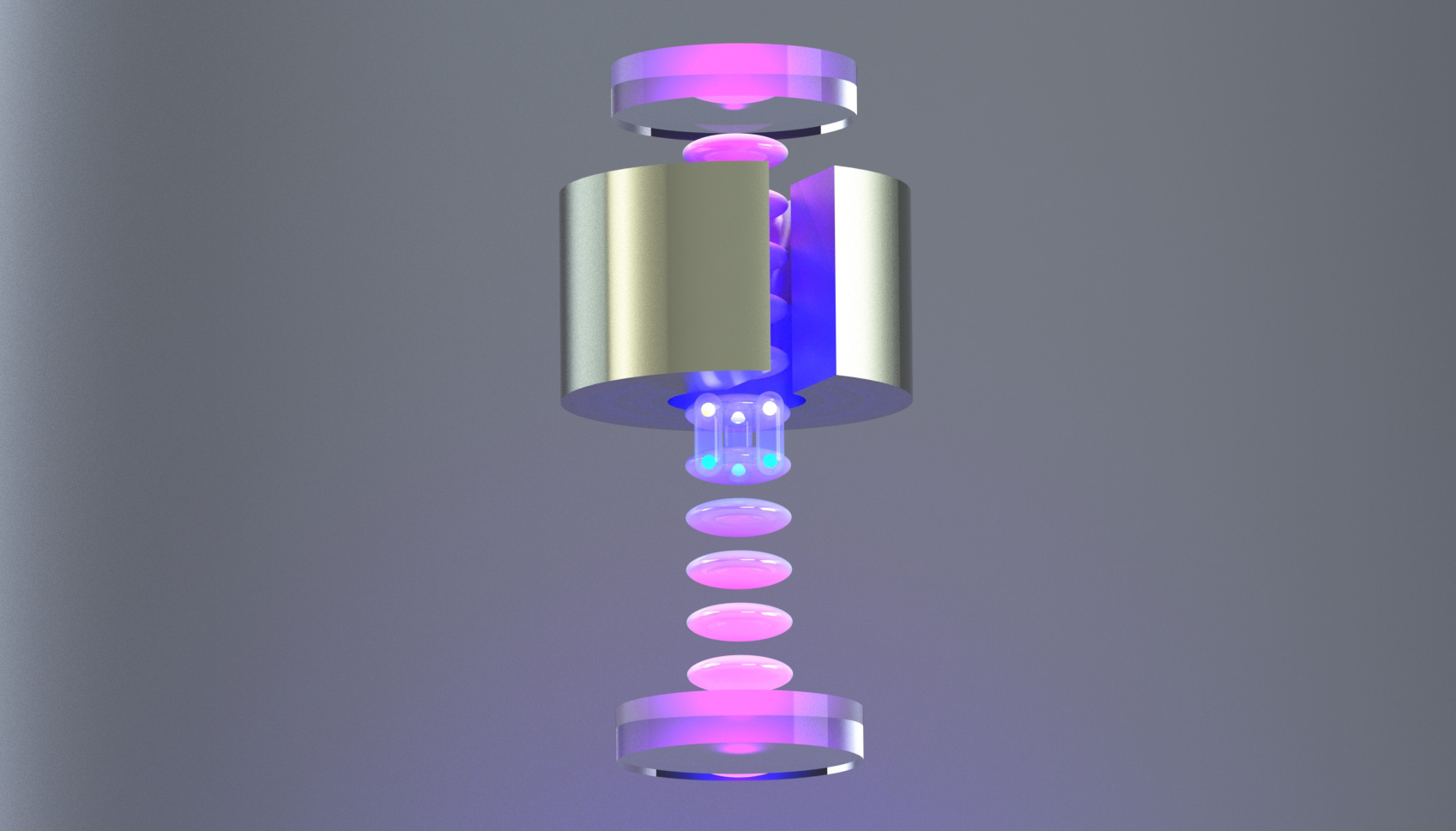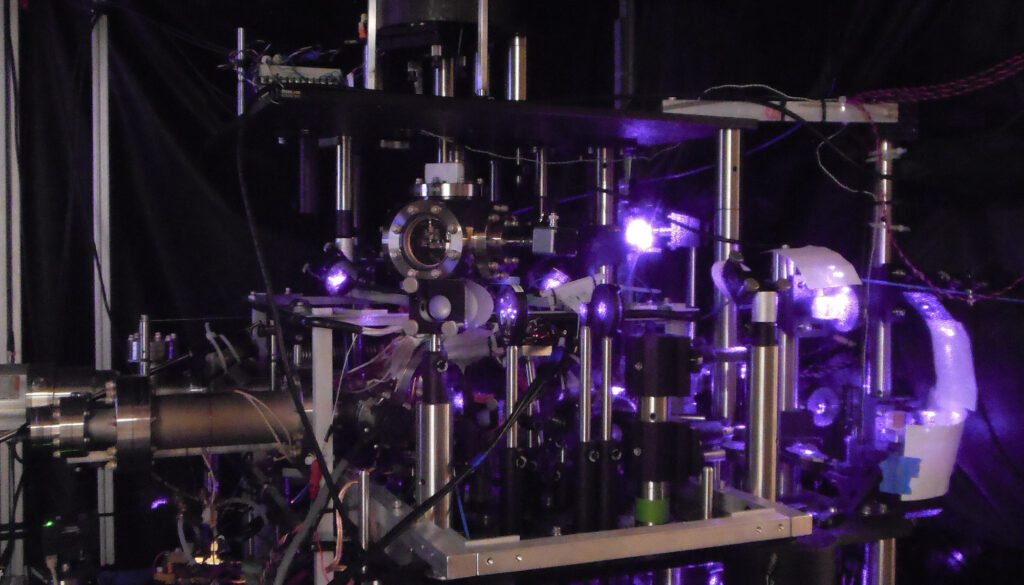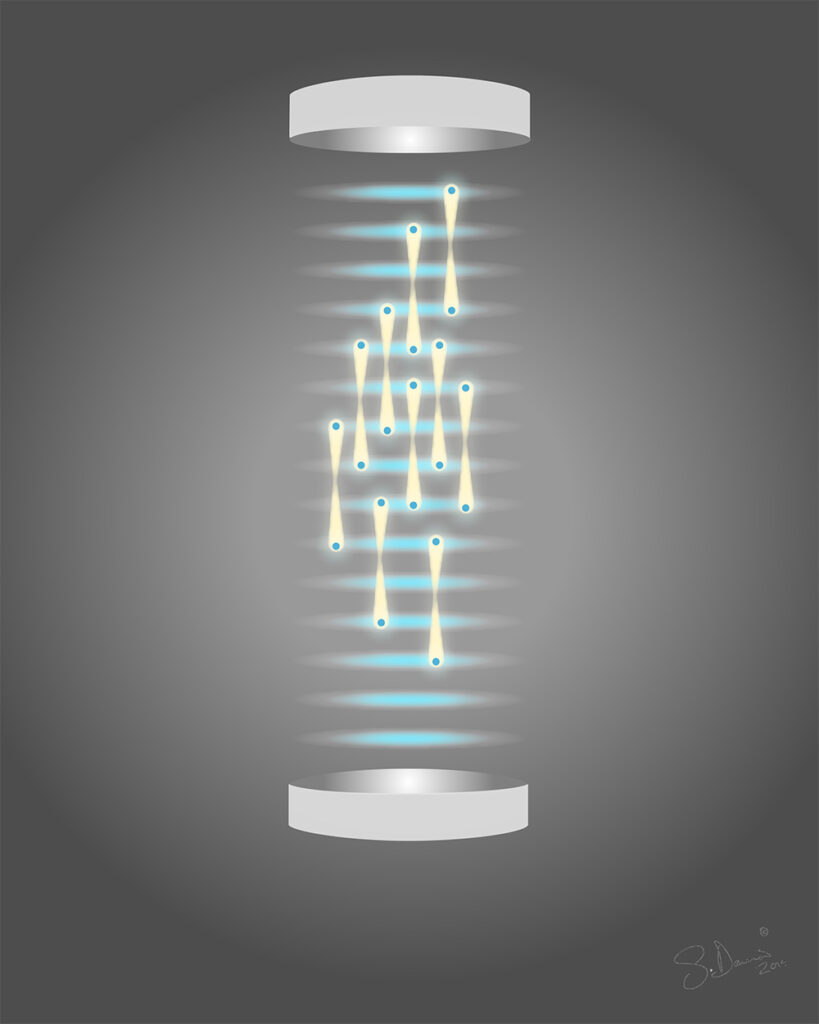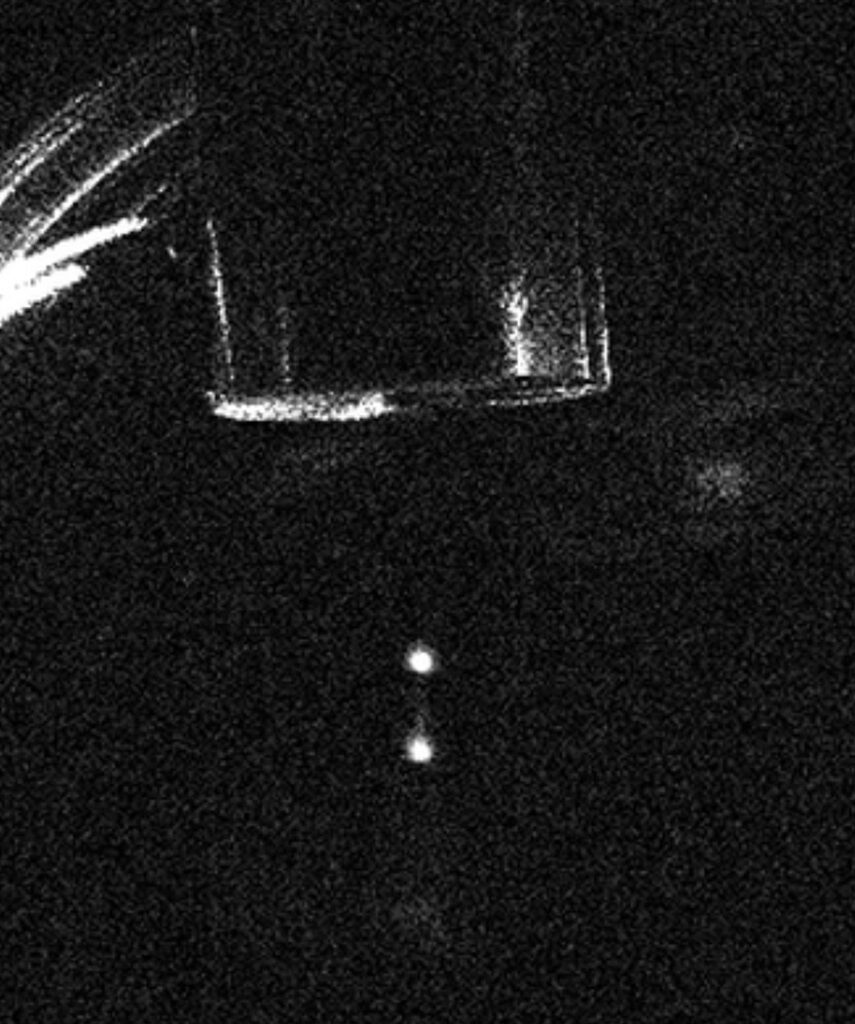With a new, incredibly precise instrument, Berkeley researchers narrow search for dark energy
Experiment captures atoms in free fall to look for gravitational anomalies caused by universe's missing energy

Cristian Panda/UC Berkeley
June 26, 2024
Dark energy — a mysterious force pushing the universe apart at an ever-increasing rate — was discovered 26 years ago, and ever since, scientists have been searching for a new and exotic particle causing the expansion.
Pushing the boundaries of this search, University of California, Berkeley physicists have now built the most precise experiment yet to look for minor deviations from the accepted theory of gravity that could be evidence for such a particle, which theorists have dubbed a chameleon or symmetron.
The experiment, which combines an atom interferometer for precise gravity measurements with an optical lattice to hold the atoms in place, allowed the researchers to immobilize free-falling atoms for seconds instead of milliseconds to look for gravitational effects, besting the current most precise measurement by a factor of five.
Though the researchers found no deviation from what is predicted by the theory spelled out by Isaac Newton 400 years ago, expected improvements in the precision of the experiment could eventually turn up evidence that supports or disproves theories of a hypothetical fifth force mediated by chameleons or symmetrons.
The ability of the lattice atom interferometer to hold atoms for up to 70 seconds — and potentially 10 times longer — also opens up the possibility of probing gravity at the quantum level, said Holger Müller, UC Berkeley professor of physics. While physicists have well-tested theories describing the quantum nature of three of the four forces of nature — electromagnetism and the strong and weak forces — the quantum nature of gravity has never been demonstrated.
“Most theorists probably agree that gravity is quantum. But nobody has ever seen an experimental signature of that,” Müller said. “It’s very hard to even know whether gravity is quantum, but if we could hold our atoms 20 or 30 times longer than anyone else, because our sensitivity increases with the second or fourth power of the hold time, we could have a 400 to 800,000 times better chance of finding experimental proof that gravity is indeed quantum mechanical.”
Aside from precision measurements of gravity, other applications of the lattice atom interferometer include quantum sensing.
“Atom interferometry is particularly sensitive to gravity or inertial effects. You can build gyroscopes and accelerometers,” said UC Berkeley postdoctoral fellow Cristian Panda, who is first author of a paper about the gravity measurements set to be published this week in the journal Nature and is co-authored by Müller. “But this gives a new direction in atom interferometry, where quantum sensing of gravity, acceleration and rotation could be done with atoms held in optical lattices in a compact package that is resilient to environmental imperfections or noise.”
Because the optical lattice holds atoms rigidly in place, the lattice atom interferometer could even operate at sea, where sensitive gravity measurements are employed to map the geology of the ocean floor.
Screened forces can hide in plain sight
Dark energy was discovered in 1998 by two teams of scientists: a group of physicists based at Lawrence Berkeley National Laboratory, led by Saul Perlmutter, now a UC Berkeley professor of physics, and a group of astronomers that included UC Berkeley postdoctoral fellow Adam Riess. The two shared the 2011 Nobel Prize in Physics for the discovery.

Courtesy of Holger Müller lab
The realization that the universe was expanding more rapidly than it should came from tracking distant supernovas and using them to measure cosmic distances. Despite much speculation by theorists about what’s actually pushing space apart, dark energy remains an enigma — a large enigma, since about 70% of the entire matter and energy of the universe is in the form of dark energy.
One theory is that dark energy is merely the vacuum energy of space. Another is that it is an energy field called quintessence, which varies over time and space.
Another proposal is that dark energy is a fifth force much weaker than gravity and mediated by a particle that exerts a repulsive force that varies with the density of surrounding matter. In the emptiness of space, it would exert a repulsive force over long distances, able to push space apart. In a laboratory on Earth, with matter all around to shield it, the particle would have an extremely small reach.
This particle has been dubbed a chameleon, as if it’s hiding in plain sight.
In 2015, Müller adapted an atom interferometer to search for evidence of chameleons using cesium atoms launched into a vacuum chamber, which mimics the emptiness of space. During the 10 to 20 milliseconds it took the atoms to rise and fall above a heavy aluminum sphere, he and his team detected no deviation from what would be expected from the normal gravitational attraction of the sphere and Earth.
The key to using free-falling atoms to test gravity is the ability to excite each atom into a quantum superposition of two states, each with a slightly different momentum that carries them different distances from a heavy tungsten weight hanging overhead. The higher momentum, higher elevation state experiences more gravitational attraction to the tungsten, changing its phase. When the atom’s wave function collapses, the phase difference between the two parts of the matter wave reveals the difference in gravitational attraction between them.
“Atom interferometry is the art and science of using the quantum properties of a particle, that is, the fact that it’s both a particle and a wave. We split the wave up so that the particle is taking two paths at the same time and then interfere them at the end,” Müller said. “The waves can either be in phase and add up, or the waves can be out of phase and cancel each other out. The trick is that whether they are in phase or out of phase depends very sensitively on some quantities that you might want to measure, such as acceleration, gravity, rotation or fundamental constants.”

Sarah Davis
In 2019, Müller and his colleagues added an optical lattice to keep the atoms close to the tungsten weight for a much longer time — an astounding 20 seconds — to increase the effect of gravity on the phase. The optical lattice employs two crossed laser beams that create a lattice-like array of stable places for atoms to congregate, levitating in the vacuum. But was 20 seconds the limit, he wondered?
During the height of the COVID-19 pandemic, Panda worked tirelessly to extend the hold time, systematically fixing a list of 40 possible roadblocks until establishing that the wiggling tilt of the laser beam, caused by vibrations, was a major limitation. By stabilizing the beam within a resonant chamber and tweaking the temperature to be a bit colder — in this case less than a millionth of a Kelvin above absolute zero, or a billion times colder than room temperature — he was able to extend the hold time to 70 seconds.
He and Müller published those results in the June 11, 2024, issue of Nature Physics.
Gravitational entanglement
In the newly reported gravity experiment, Panda and Müller traded a shorter time, 2 seconds, for a greater separation of the wave packets to several microns, or several thousandths of a millimeter. There are about 10,000 cesium atoms in the vacuum chamber for each experiment — too sparsely distributed to interact with one another — dispersed by the optical lattice into clouds of about 10 atoms each.

Cristian Panda, UC Berkeley
“Gravity is trying to push them down with a force a billion times stronger than their attraction to the tungsten mass, but you have the restoring force from the optical lattice that’s holding them, kind of like a shelf,” Panda said. “We then take each atom and split it into two wave packets, so now it’s in a superposition of two heights. And then we take each one of those two wave packets and load them in a separate lattice site, a separate shelf, so it looks like a cupboard. When we turn off the lattice, the wave packets recombine, and all the quantum information that was acquired during the hold can be read out.”
Panda plans to build his own lattice atom interferometer at the University of Arizona, where he was just appointed an assistant professor of physics. He hopes to use it to, among other things, more precisely measure the gravitational constant that links the force of gravity with mass.
Meanwhile, Müller and his team are building from scratch a new lattice atom interferometer with better vibration control and a lower temperature. The new device could produce results that are 100 times better than the current experiment, sensitive enough to detect the quantum properties of gravity. The planned experiment to detect gravitational entanglement, if successful, would be akin to the first demonstration of quantum entanglement of photons performed at UC Berkeley in 1972 by the late Stuart Freedman and former postdoctoral fellow John Clauser. Clauser shared the 2022 Nobel Prize in Physics for that work.
Other co-authors of the gravity paper are graduate student Matthew Tao and former undergraduate student Miguel Ceja of UC Berkeley, Justin Khoury of the University of Pennsylvania in Philadelphia and Guglielmo Tino of the University of Florence in Italy. The work is supported by the National Science Foundation (1708160, 2208029), Office of Naval Research (N00014-20-1-2656) and Jet Propulsion Laboratory (1659506, 1669913).